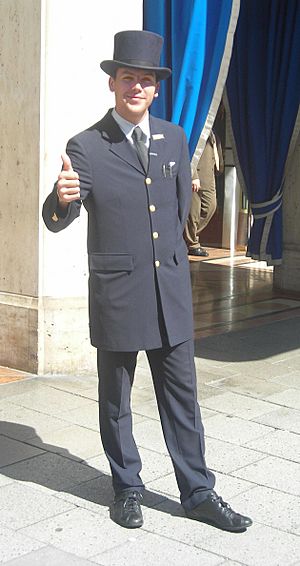Service (economics) facts for kids
In the world of business, a service is like a helpful action or task that someone does for another person or company. It's something you buy or sell, but it's not a physical item you can hold. Think of it as an activity or work offered as a product.
Even though a service itself isn't a physical thing, the result of a service can sometimes be a physical item. For example, when you hire a construction service, they build something real like a house. But if you pay for a lawn mowing service, you get a mowed lawn, not a new physical product. When you buy a service, you usually don't own the service itself, but you might own any physical thing that comes from it.
Contents
- What Makes Services Special?
- You Can't Touch Them (Intangibility)
- They Disappear If Not Used (Perishability)
- You Can't Move Them Around (Lack of Transportability)
- Each Time Is Different (Variability)
- Mostly Human Work (Labour Intensity)
- Demand Changes Quickly (Demand Fluctuations)
- You Need to Be Involved (Buyer Involvement)
- Building Long-Term Relationships (Client-Based Relationships)
- Related pages
- Images for kids
- See also
What Makes Services Special?
Services have some key features that make them different from physical products.
You Can't Touch Them (Intangibility)
Services are intangible, meaning you can't see, touch, smell, or hold them. They are experiences or actions.
- You can't put a haircut in a box or store a taxi ride for later.
- Because services are hard to show before you buy them, businesses often try to create a clear picture in your mind of what you'll get. This also means it can be tricky for customers to know the full value of a service until they've experienced it.
They Disappear If Not Used (Perishability)
Services are perishable. This means if they aren't used at a specific time, that opportunity is lost forever.
- Imagine a doctor who has an empty appointment slot. If no one books it, that hour of potential work is gone. She can't "save" that hour to work later.
- Think of an empty seat on an airplane after it takes off, or an unsold ticket to a concert after the show starts. Those services are lost opportunities.
You Can't Move Them Around (Lack of Transportability)
Most services are used right where they are "produced." You can't usually transport a service.
- You have to go to the hair salon to get a haircut; the haircut can't be delivered to your house like a package.
- A live concert happens in one place, and you have to be there to experience it.
Each Time Is Different (Variability)
Services often change a little bit each time they are provided, or for each person. This is called variability or lack of homogeneity.
- It's hard to make every service exactly the same, like you can with products made in a factory.
- For example, if you take a taxi to school on Monday, and then again on Tuesday with the same driver and car, the two rides won't be exactly identical. The traffic might be different, or the driver might take a slightly different route.
Mostly Human Work (Labour Intensity)
Services usually involve a lot of human effort and activity. This means the people providing the service are very important to its success.
- A teacher, a chef, or a plumber all provide services that depend heavily on their skills and actions.
- Because people are so involved, it can be hard for one service company to completely dominate the market.
Demand Changes Quickly (Demand Fluctuations)
The need for services can change a lot, sometimes very quickly. This is called demand fluctuation.
- It can be tough to guess how many people will want a service at any given time.
- For example, a restaurant might be super busy during dinner time but almost empty in the middle of the afternoon. Demand can also change with the season or time of day.
You Need to Be Involved (Buyer Involvement)
When you get a service, you often have to be part of the process. There's usually a lot of interaction between you (the client) and the person or company providing the service.
- To get a medical check-up, you need to be there and talk to the doctor.
- When you get a custom-made cake, you work with the baker to decide on the design and flavors.
Building Long-Term Relationships (Client-Based Relationships)
Many service businesses focus on building strong, long-lasting relationships with their customers.
- If a customer is happy with a service, they are likely to come back again and again, even if there's a cheaper option somewhere else.
- Think of accountants or financial advisers who often work with the same clients for many years. Happy clients often tell their friends and family, which helps the business grow.
Related pages
Images for kids
See also
 In Spanish: Servicio (economía) para niños
In Spanish: Servicio (economía) para niños



